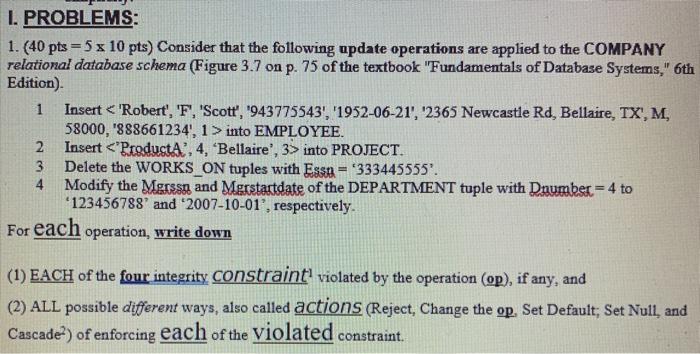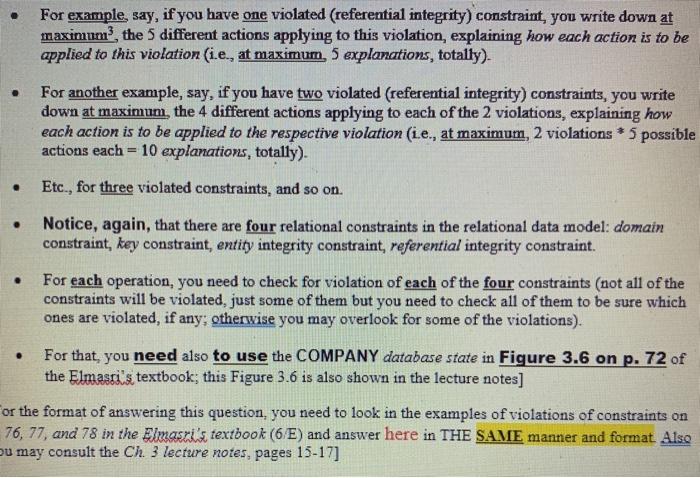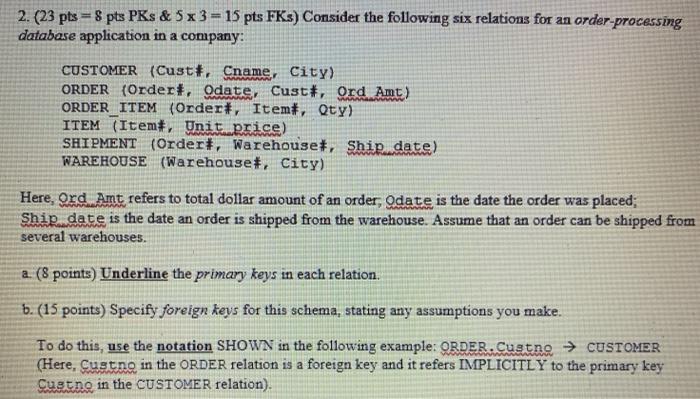I. PROBLEMS: 1. (40 pts=5 x 10 pts) Consider that the following update operations are applied to the COMPANY relational database schema (Figure 3.7 on p. 75 of the textbook "Fundamentals of Database Systems," 6th Edition) 1 Insert into EMPLOYEE. 2 Insert into PROJECT. 3 Delete the WORKS ON tuples with Essa = "333445555'. 4 Modify the Mass and Mgrstartdate of the DEPARTMENT tuple with Dnumber= 4 to 123456788' and '2007-10-01', respectively. For each operation, write down (1) EACH of the four integrity constraint violated by the operation (op), if any, and (2) ALL possible different ways, also called actions (Reject, Change the op. Set Default; Set Null, and Cascade?) of enforcing each of the violated constraint. For example say, if you have one violated (referential integrity) constraint, you write down at maximum, the 5 different actions applying to this violation, explaining how each action is to be applied to this violation (i.e., at maximum. 5 explanations, totally). . For another example, say, if you have two violated (referential integrity) constraints, you write down at maximum the 4 different actions applying to each of the 2 violations, explaining how each action is to be applied to the respective violation (i.e., at maximum, 2 violations * 5 possible actions each = 10 explanations, totally). . Etc., for three violated constraints, and so on. . Notice, again, that there are four relational constraints in the relational data model: domain constraint, key constraint, entity integrity constraint, referential integrity constraint. For each operation, you need to check for violation of each of the four constraints (not all of the constraints will be violated, just some of them but you need to check all of them to be sure which ones are violated, if any, otherwise you may overlook for some of the violations). . For that, you need also to use the COMPANY database state in Figure 3.6 on p. 72 of the Elmasri's textbook, this Figure 3.6 is also shown in the lecture notes] For the format of answering this question, you need to look in the examples of violations of constraints on 76, 77, and 78 in the Elmasri's textbook (6/E) and answer here in THE SAME manner and format. Also ou may consult the Ch. 3 lecture notes, pages 15-17] 2. (23 pts = 8 pts PKs & 5 x 3 - 15 pts FKs) Consider the following six relations for an order-processing database application in a company: CUSTOMER (CustCname, City) ORDER (Ordert, Odate, Cust#, Ord Amt) ORDER ITEM (Order#, Item#, Qty) ITEM (Itemi, Unit Price) SHIPMENT (Ordert, Warehouse, Ship date) WAREHOUSE (Warehouset, City) Here, Ord Amt refers to total dollar amount of an order, Odate is the date the order was placed; Ship date is the date an order is shipped from the warehouse. Assume that an order can be shipped from several warehouses. a (8 points) Underline the primary keys in each relation. b. (15 points) Specify foreign keys for this schema, stating any assumptions you make. To do this, use the notation SHOWN in the following example: ORDER.Custno CUSTOMER (Here, Custno in the ORDER relation is a foreign key and it refers IMPLICITLY to the primary key Custne in the CUSTOMER relation)









